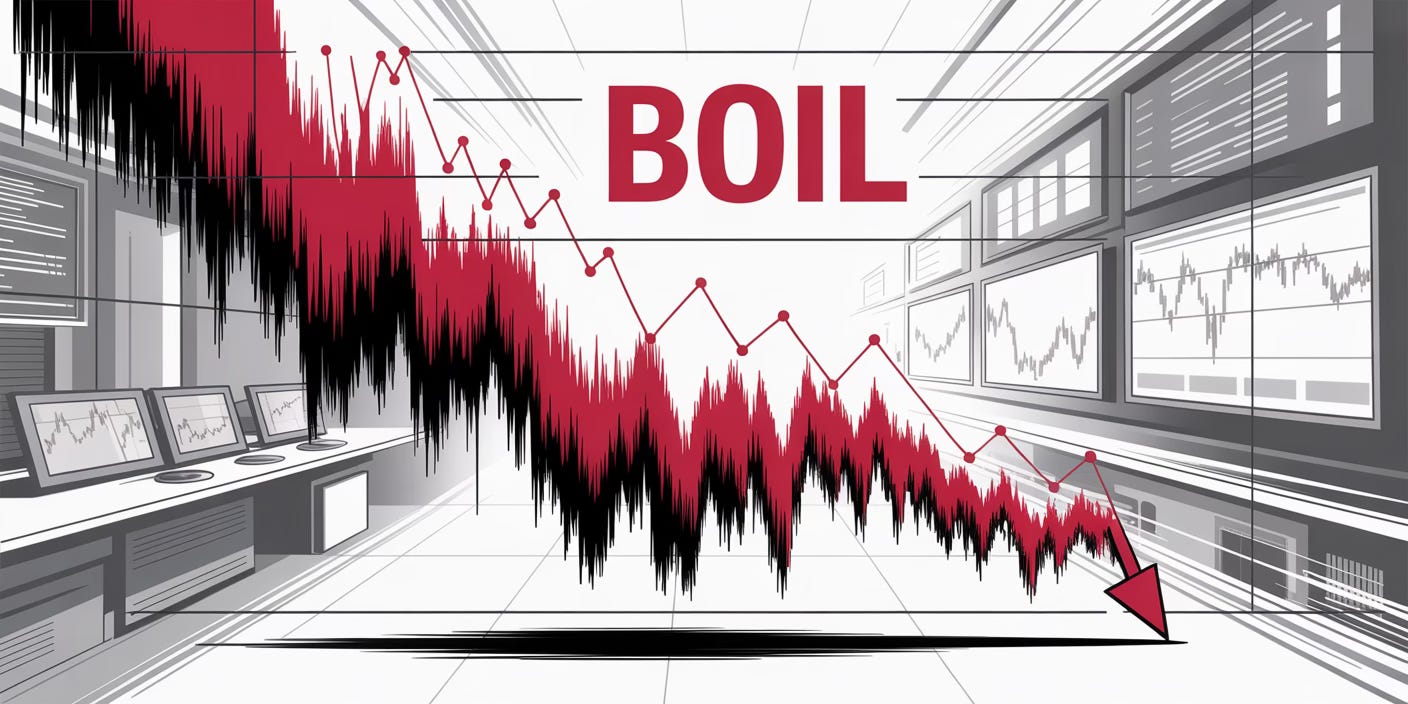Understanding BOIL: Why the 2x Leveraged Natural Gas ETF Is Not A Buy-and-Hold Investment
In the landscape of exchange-traded products (ETPs), few are as enticing—and as misunderstood—as BOIL, the 2x leveraged natural gas ETF. At first glance, BOIL looks like a simple way to double your money if natural gas prices rise. But beneath that simplicity lies a decaying instrument designed for short-term speculation, not long-term investing.
This article explains what BOIL is, why it erodes over time, why it should not be held long-term, who might use it effectively, and who should avoid it entirely.
What Is BOIL?
BOIL is an ETF that seeks to deliver twice the daily percentage change of a natural gas futures index.
Specifically, it tracks an index of front-month natural gas futures, applying 2x daily leverage.
Like UVIX with the VIX, BOIL does not hold the commodity directly. Instead, it owns futures contracts, which behave differently than the spot price you see quoted in headlines.
Bottom line: BOIL is a 2x leveraged bet on short-term natural gas futures—not on natural gas prices at your utility bill.
Why Does BOIL Go Down Over Time?
Pull up a long-term chart of BOIL, and you’ll see a familiar pattern: relentless decay punctuated by the occasional explosive rally. This trend is the result of two structural forces:
1. Contango in Natural Gas Futures
Natural gas futures are frequently in contango, meaning longer-dated contracts cost more than near-term ones.
To maintain exposure, BOIL must roll futures contracts: sell cheaper expiring ones, buy more expensive new ones.
This roll cost acts like a steady drag on performance, eating away value over time.
2. Leverage and Beta Slippage
BOIL resets daily, aiming for 2x the index’s daily change.
In volatile, choppy markets (common in natural gas), compounding works against holders.
Even if natural gas prices end flat, BOIL tends to lose value due to slippage from leverage reset.
The result: BOIL is structurally biased to decay.
Why BOIL Is Not a Buy-and-Hold Vehicle
Natural gas is famously volatile, but that doesn’t make BOIL a sound investment.
Over the long run, BOIL trends toward zero due to roll costs and leverage decay.
Big payoffs come only during short-lived natural gas rallies.
For most of the time, BOIL bleeds away capital steadily.
In short: BOIL is a trading tool, not an investment.
Who Can Use BOIL?
BOIL does serve a purpose—but only for a narrow slice of market participants:
Short-Term Speculators
Traders betting on a near-term surge in natural gas (e.g., during extreme weather, storage reports, or geopolitical shocks).
Time horizons: days, not months.
Tactical Hedgers
Market participants who want a short-term hedge against energy-related exposure.
Timing is everything—any long delay erodes the hedge.
Options Traders
Advanced traders sometimes use BOIL options as an underlying for energy volatility strategies.
Who Should Avoid BOIL?
❌ Long-Term Investors
Those looking to “play” natural gas prices over months or years will be disappointed.
The math of contango and leverage reset guarantees underperformance.
❌ Beginners
Without understanding roll decay, leverage mechanics, and commodity futures structures, beginners often hold BOIL too long—leading to catastrophic losses.
Historical Context
BOIL’s track record is clear:
Despite periodic massive spikes in natural gas prices (e.g., during the 2022 energy crisis), BOIL has lost the vast majority of its value over time.
Reverse splits keep it trading, but they don’t solve the problem of structural decay.
Like UVIX, BOIL is engineered to exist indefinitely—but not to preserve investor wealth.
Key Takeaways
BOIL is a 2x leveraged natural gas futures ETF, not direct exposure to spot natural gas.
It decays over time due to futures roll costs and leverage reset.
It is a short-term speculative vehicle, not a buy-and-hold investment.
Suitable for: tactical traders, event-driven strategies, and short-term hedges.
Not suitable for: long-term investors, beginners, or anyone treating it like a normal ETF.
Final Thoughts
BOIL is seductive but dangerous. It’s a high-volatility trading instrument designed for short bursts of speculation, not for long-term wealth-building. Traders who understand commodity term structures, futures dynamics, and leverage decay can use BOIL strategically. Beginners who treat it like a traditional stock or ETF, however, often learn the hard way why BOIL’s chart looks like a slow-motion crash.
In short: BOIL is a matchstick—powerful in the right moment, but not meant to stay lit.



